Towards More Accurate Risk Assessment of Sediment Trace Metals: Integrating Sedimentary Background Determination and Probabilistic Evaluation in Chaohu Lake, China
Abstract
1. Introduction
2. Materials and Methods
2.1. Study Area
2.2. Sample Collection
2.3. Determination of Sediment Accumulation Rates Based on 210Pbex Dating
2.4. Methods of Data Processing
2.4.1. Geo-Accumulation Index (Igeo)
2.4.2. The Potential Ecological Risk Index
2.4.3. Ecological Risk Assessment Conducted Based on the Total Volume
3. Results
3.1. Sedimentary History and Depth Prediction
3.2. Vertical Distribution of Trace Metals in Sediments
3.3. Ecological Risk of Trace Metals in Sediments
4. Discussion
4.1. Main Factor Analysis Based on Risks of Trace Metals
4.2. Risk Assessment of Trace Metals Mixtures
4.3. Comparative Analysis of Risk Assessment
4.4. Broader Contextualization of Ecological Risk Assessment Results
5. Conclusions
Author Contributions
Funding
Data Availability Statement
Conflicts of Interest
References
- Sojka, M.; Jaskuła, J.; Barabach, J.; Ptak, M.; Zhu, S. Heavy metals in lake surface sediments in protected areas in Poland: Concentration, pollution, ecological risk, sources and spatial distribution. Sci. Rep. 2022, 12, 15006. [Google Scholar] [CrossRef] [PubMed]
- Luo, W.; Lu, J. Inhibition of in situ coating of sediment ceramsite on sediment nutrient release of eutrophic lakes. Environ. Geochem. Health 2022, 44, 1471–1485. [Google Scholar] [CrossRef]
- Lin, Q.; Liu, E.F.; Zhang, E.L.; Li, K.; Shen, J. Spatial distribution, contamination and ecological risk assessment of heavy metals in surface sediments of Erhai Lake, a large eutrophic plateau lake in southwest China. Catena 2016, 145, 193–203. [Google Scholar] [CrossRef]
- Liang, M.; Liu, E.; Wang, X.; Zhang, Q.; Xu, J.; Jin, M.; Zhang, E. Historical trends in atmospheric metal(loid) contamination in North China over the past half-millennium reconstructed from subalpine lake sediment. Environ. Pollut. 2022, 304, 119195. [Google Scholar] [CrossRef] [PubMed]
- Wang, R.; Xia, W.; Eggleton, M.A.; Qu, X.; Liu, H.; Xin, W.; Wu, X.; Chen, Y. Spatial and temporal patterns of heavy metals and potential human impacts in Central Yangtze lakes, China. Sci. Total Environ. 2022, 820, 153368. [Google Scholar] [CrossRef]
- Huang, J.; Zhang, Y.; Arhonditsis, G.B.; Gao, J.; Chen, Q.; Wu, N.; Dong, F.; Shi, W. How successful are the restoration efforts of China’s lakes and reservoirs? Environ. Int. 2019, 123, 96–103. [Google Scholar] [CrossRef]
- Liu, C.; Fan, C.; Shen, Q.; Shao, S.; Zhang, L.; Zhou, Q. Effects of riverine suspended particulate matter on post-ridging metal re-contamination across the sediment-water interface. Chemosphere 2016, 144, 2329–2335. [Google Scholar] [CrossRef]
- Zhu, S.; Zhang, Z.; Zagar, D. Mercury transport and fate models in aquatic systems: A review and synthesis. Sci. Total Environ. 2018, 639, 538–549. [Google Scholar] [CrossRef]
- Sun, L.; Guo, D.; Liu, K.; Meng, H.; Zheng, Y.; Yuan, F.; Zhu, G. Levels, sources, and spatial distribution of heavy metals in soils from a typical coal industrial city of Tangshan, China. Catena 2019, 175, 101–109. [Google Scholar] [CrossRef]
- Chen, M.; Ding, S.; Li, C.; Tang, Y.; Fan, X.; Xu, H.; Tsang, D.C.W.; Zhang, C. High cadmium pollution from sediments in a eutrophic lake caused by dissolved organic matter complexation and reduction of manganese oxide. Water Res. 2021, 190, 116711. [Google Scholar] [CrossRef]
- Nazarpour, A.; Watts, M.J.; Madhani, A.; Elahi, S. Source, spatial distribution and pollution assessment of Pb, Zn, Cu, and Pb, Isotopes in urban soils of Ahvaz City, a semi-arid metropolis in southwest Iran. Sci. Rep. 2019, 9, 5349. [Google Scholar] [CrossRef] [PubMed]
- Jia, Z.; Zhou, S.; Su, Q.; Yi, H.; Wang, J. Comparison study on the estimation of the spatial distribution of regional soil metal (loid)s pollution based on kriging interpolation and BP neural network. Int. J. Environ. Res. Public Health 2017, 15, 34. [Google Scholar] [CrossRef]
- Montes, C.D.S.; Ferreira, M.A.P.; Giarrizzo, T.; Amado, L.L.; Rocha, R.M. Evaluation of metal contamination effects in piranhas through biomonitoring and multi biomarkers approach. Heliyon 2020, 6, e04666. [Google Scholar] [CrossRef] [PubMed]
- Qin, Y.; Tao, Y. Pollution status of heavy metals and metalloids in Chinese lakes: Distribution, bioaccumulation and risk assessment. Ecotoxicol. Environ. Saf. 2022, 248, 114293. [Google Scholar] [CrossRef]
- Valero, A.; Umbría-Salinas, K.; Wallner-Kersanach, M.; Andrade, C.F.; Yabe, M.J.S.; Pereira, L.C.; Wasserman, J.S.; Kuroshima, K.N.; Zhang, H. Potential availability of trace metals in sediments in southeastern and southern Brazilian shipyard areas using the DGT technique and chemical extraction methods. Sci. Total Environ. 2020, 710, 136216. [Google Scholar] [CrossRef]
- Razak, M.R.; Aris, A.Z.; Zakaria, N.A.C.; Wee, S.Y.; Ismail, N.A.H. Accumulation and risk assessment of heavy metals employing species sensitivity distributions in Linggi River, Negeri Sembilan, Malaysia. Ecotoxicol. Environ. Saf. 2021, 211, 111905. [Google Scholar] [CrossRef] [PubMed]
- Guan, Q.; Liu, Z.; Shao, W.; Tian, J.; Luo, H.; Ni, F.; Shan, Y. Probabilistic risk assessment of heavy metals in urban farmland soils of a typical oasis city in Northwest China. Sci. Total Environ. 2022, 833, 155096. [Google Scholar] [CrossRef]
- Zhang, H.; Huo, S.; Yeager, K.M.; Xi, B.; Zhang, J.; Wu, F. A historical sedimentary record of mercury in a shallow eutrophic lake: Impacts of human activities and climate change. Engineering 2019, 5, 296–304. [Google Scholar] [CrossRef]
- Li, X.; Yang, Y.; Yang, J.; Fan, Y.; Qian, X.; Li, H. Rapid diagnosis of heavy metal pollution in lake sediments based on environmental magnetism and machine learning. J. Hazard. Mater. 2021, 416, 126163. [Google Scholar] [CrossRef]
- Liu, E.; Shen, J. A comparative study of metal pollution and potential eco-risk in the sediment of Chaohu Lake (China) based on total concentration and chemical speciation. Environ. Sci. Pollut. Res. 2014, 21, 7285–7295. [Google Scholar] [CrossRef]
- Wu, L.; Liu, G.; Zhou, C.; Xi, S.; Da, C.; Liu, F. Spatial distributions, fractionation characteristics, and ecological risk assessment of trace elements in sediments of Chaohu Lake, a large eutrophic freshwater lake in eastern China. Environ. Sci. Pollut. Res. 2018, 25, 588–600. [Google Scholar] [CrossRef] [PubMed]
- Luo, W.; Yue, Y.; Lu, J.; Pang, L.; Zhu, S. Sediment phosphate release flux under hydraulic disturbances in the shallow lake of Chaohu, China. Environ. Sci. Pollut. Res. 2022, 29, 60843–60851. [Google Scholar] [CrossRef]
- Luo, W.; Pan, Y.; Fan, Y.; Lu, J.; Zhu, S. Distribution Patterns of Sediment Organic Carbon Stocks in Shallow Lakes and the Significance for Sustainable Lake Management: Chaohu Lake in Eastern China as a Case Study. Land 2024, 13, 507. [Google Scholar] [CrossRef]
- Appleby, P.G.; Oldfield, F. The calculation of 210Pb dates assuming a constant rate of supply of unsupported 210Pb to the sediment. Catena 1978, 5, 1–8. [Google Scholar] [CrossRef]
- Müller, G. Index of geo-accumulation in sediments of the Rhine River. Geochem. J. 1969, 2, 108–118. [Google Scholar]
- Fang, T.; Lu, W.; Cui, K.; Li, J.; Yang, K.; Zhao, X.; Liang, Y.; Li, H. Distribution, bioaccumulation and trophic transfer of trace metals in the food web of Chaohu Lake, Anhui, China. Chemosphere 2019, 218, 1122–1130. [Google Scholar] [CrossRef] [PubMed]
- Hakanson, L. An ecological risk index for aquatic pollution control—A sedimentological approach. Water Res. 1980, 14, 975–1001. [Google Scholar] [CrossRef]
- Pedersen, F.; Bjørnestad, E.; Andersen, H.V.; Kjølholt, J.; Poll, C. Characterization of sediments from Copenhagen harbour by use of biotests. Water Sci. Technol. 1998, 37, 233–240. [Google Scholar] [CrossRef]
- Niu, Y.; Pang, Y.; Yu, H. Assessment of heavy metal pollution in sediments of inflow rivers to Lake Taihu, China. Bull. Environ. Contam. Toxicol. 2015, 95, 618–623. [Google Scholar] [CrossRef]
- Yin, F.; Zhang, Z. Survey of Chaohu Lake eutrophication research. J. Lake Sci. 2003, 15, 377–384. (In Chinese) [Google Scholar] [CrossRef]
- Fang, T.; Wang, H.; Liang, Y.; Cui, K.; Yang, K.; Lu, W.; Li, J.; Zhao, X.; Gao, N.; Yu, Q.; et al. Source tracing with cadmium isotope and risk assessment of heavy metals in sediment of an urban river, China. Environ. Pollut. 2022, 305, 119325. [Google Scholar] [CrossRef]
- Tang, W.; Shan, B.; Zhang, H.; Mao, Z. Heavy metal sources and associated risk in response to agricultural intensification in the estuarine sediments of Chaohu Lake Valley, East China. J. Hazard. Mater. 2010, 176, 945–951. [Google Scholar] [CrossRef] [PubMed]
- Cui, Z.; Wang, Y.; Zhao, N.; Yu, R.; Xu, G.; Yu, Y. Spatial distribution and risk assessment of heavy metals in paddy soils of Yongshuyu irrigation area from Songhua River Basin, Northeast China. Chin. Geogr. Sci. 2018, 28, 797–809. [Google Scholar] [CrossRef]
- Fei, X.; Christakos, G.; Xiao, R.; Ren, Z.; Liu, Y.; Lv, X. Improved heavy metal mapping and pollution source apportionment in Shanghai City soils using auxiliary information. Sci. Total Environ. 2019, 661, 168–177. [Google Scholar] [CrossRef] [PubMed]
- Solomon, K.R.; Giesy, J.P.; LaPoint, T.W.; Giddings, J.M.; Richards, R.P. Ecological risk assessment of atrazine in North American surface waters. Environ. Toxicol. Chem. 2013, 32, 10–11. [Google Scholar] [CrossRef]
- Yu, Z.; Liu, E.; Lin, Q.; Zhang, E.; Yang, F.; Wei, C.; Shen, J. Comprehensive assessment of heavy metal pollution and ecological risk in lake sediment by combining total concentration and chemical partitioning. Environ. Pollut. 2021, 269, 116212. [Google Scholar] [CrossRef]
- Amato, E.D.; Wadige, C.P.M.; Taylor, A.M.; Maher, W.A.; Simpson, S.L.; Jolley, D.F. Field and laboratory evaluation of DGT for predicting metal bioaccumulation and toxicity in the freshwater bivalve Hyridella australis exposed to contaminated sediments. Environ. Pollut. 2018, 243, 862–871. [Google Scholar] [CrossRef]
- Gu, Y.; Huang, H.; Jiang, S.; Gong, X.; Liao, X.; Dai, M. Appraising ecotoxicological risk of mercury species and their mixtures in sediments to aquatic biota using diffusive gradients in thin films (DGT). Sci. Total Environ. 2022, 825, 154069. [Google Scholar] [CrossRef]
- Cai, Y.J.; Wei, J.H.; Zhang, S.Y.; Wang, X.L.; Zhang, Z.M.; Gao, J.F. Spatial risk assessment and source identification of heavy metals in riverine sediments of Lake Chaohu basin, China. Ecosyst. Health Sustain. 2023, 9, 0040. [Google Scholar] [CrossRef]
- Zhang, L.; Liao, Q.; Shao, S.; Zhang, N.; Shen, Q.; Liu, C. Heavy metal pollution, fractionation, and potential ecological risks in sediments from Lake Chaohu (Eastern China) and the surrounding rivers. Int. J. Environ. Res. Public Health 2015, 12, 14115–14131. [Google Scholar] [CrossRef]
- Gui, L.; Peng, S.C.; Chen, T.H.; Wang, J.Z. Evaluation of sediment-associated heavy metal pollution in Chaohu Lake, eastern China. Water Resour. 2019, 46, 614–623. [Google Scholar] [CrossRef]
- Yuan, H.; Liu, E.; Shen, J. The accumulation and potential ecological risk of heavy metals in microalgae from a eutrophic lake (Taihu Lake, China). Environ. Sci. Pollut. Res. 2015, 22, 17123–17134. [Google Scholar] [CrossRef] [PubMed]
- Loizeau, J.L.; Jiranek, G.; Cobelo-García, A.; Filella, M. Recent depositional history of noble and critical elements in sediments from a wastewater-impacted bay (Vidy Bay, Lake Geneva, Switzerland). Appl. Geochem. 2025, 178, 106240. [Google Scholar] [CrossRef]
- Han, Y.; Kristensen, N.P.; Buckley, Y.M.; Maple, D.J.; West, J.; McDonald-Madden, E. Predicting the ecosystem-wide impacts of eradication with limited information using a qualitative modelling approach. Ecol. Model. 2020, 430, 109122. [Google Scholar] [CrossRef]
- Oliver, L.; Sinnathamby, S.; Purucker, S.; Raimondo, S. A probabilistic approach to chronic effects assessments for listed species in a vernal pool case study. Integr. Environ. Assess. Manag. 2024, 20, 1654–1666. [Google Scholar] [CrossRef]
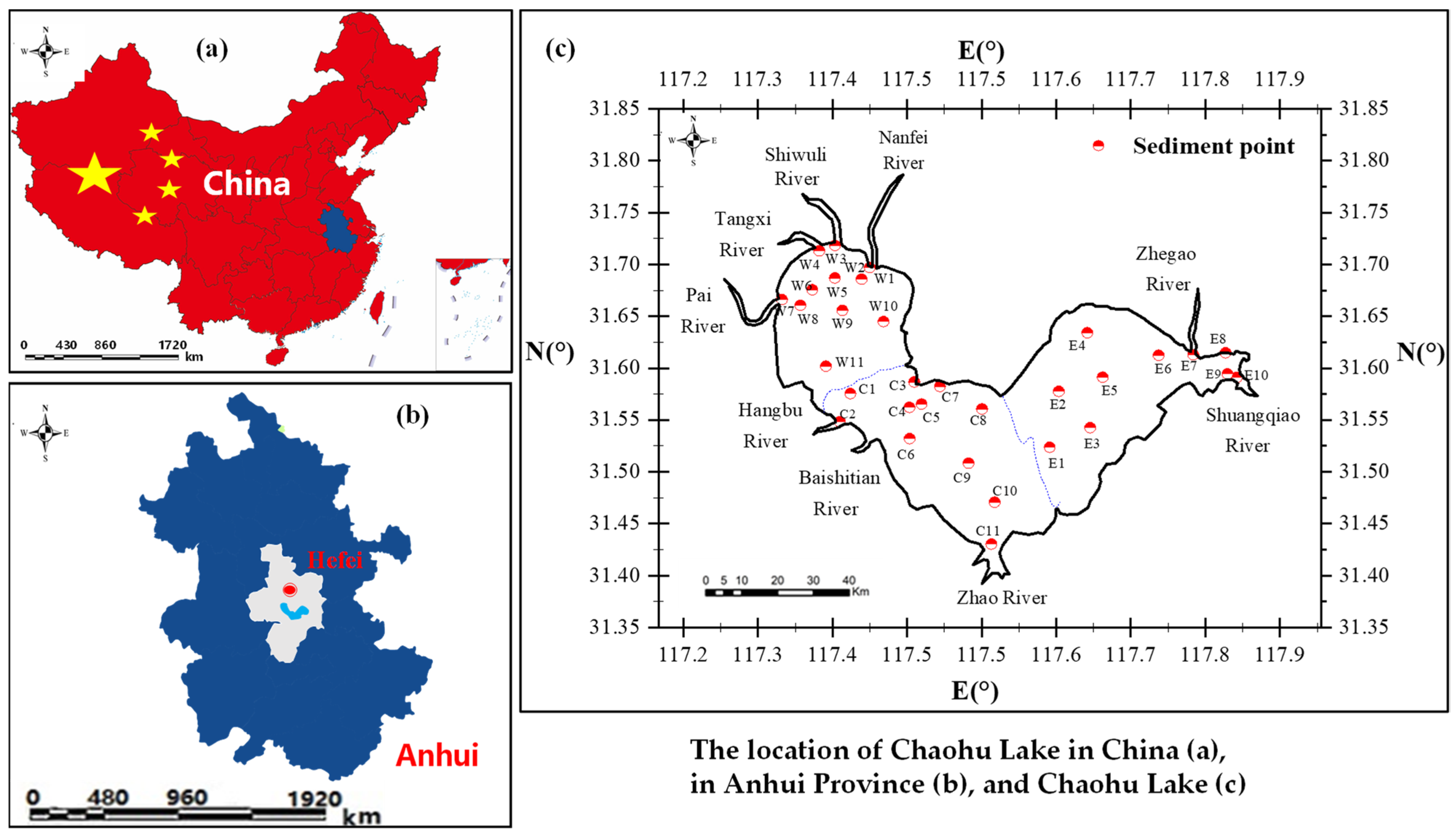
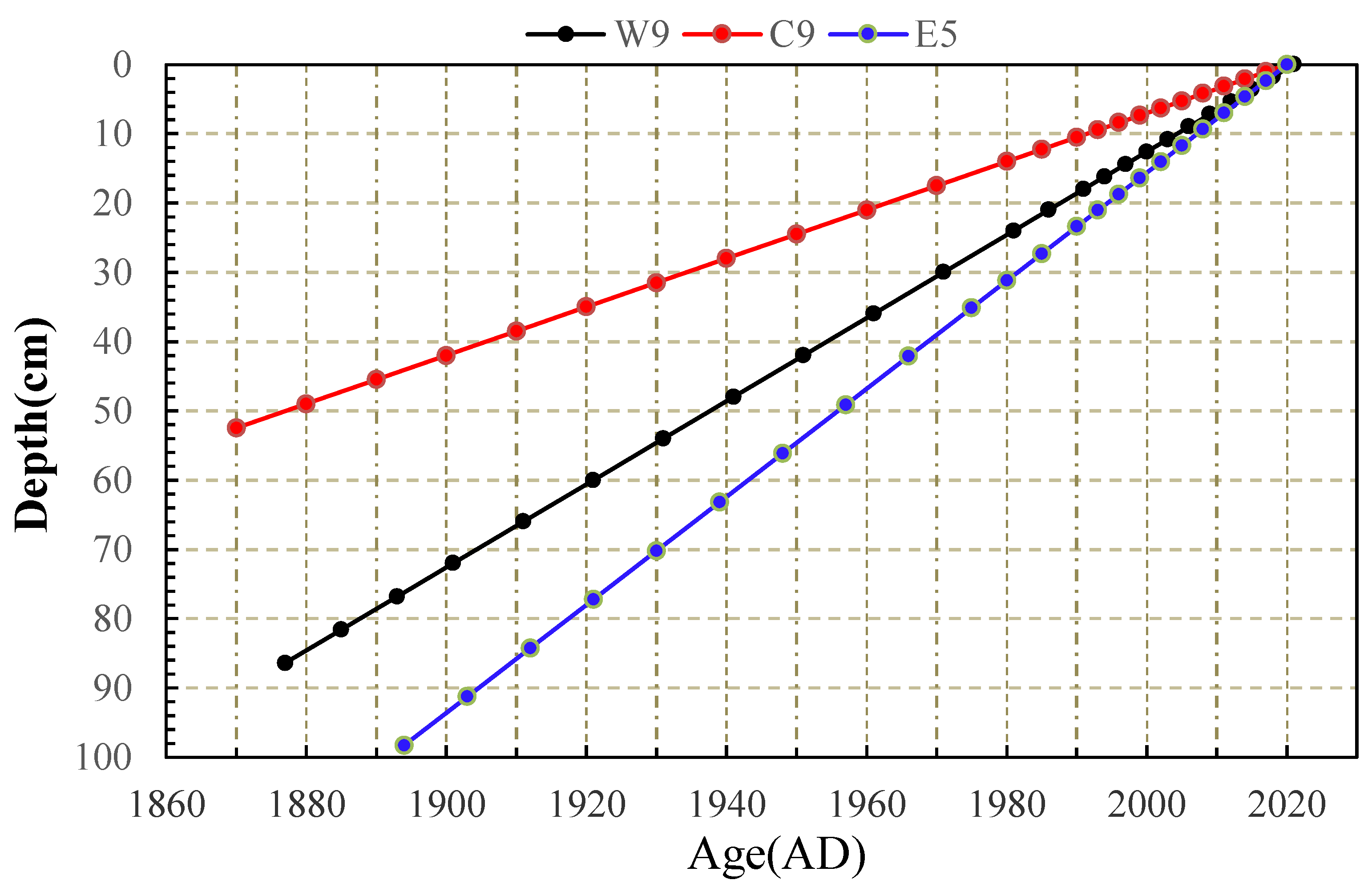


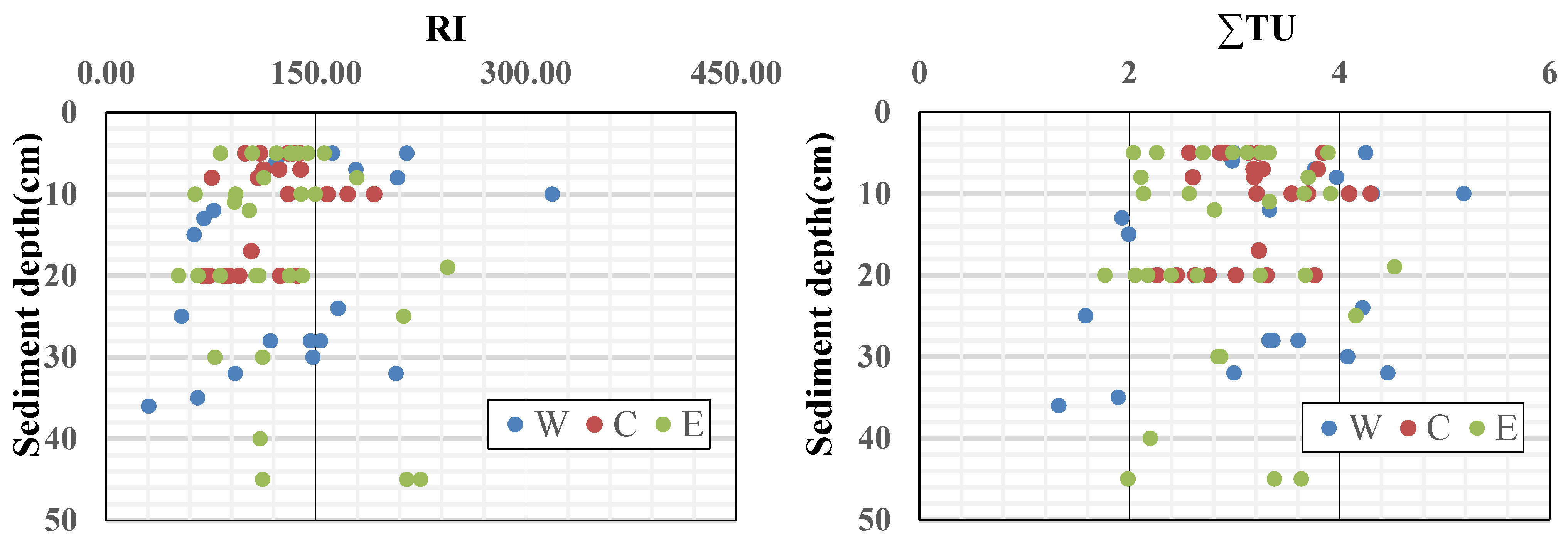
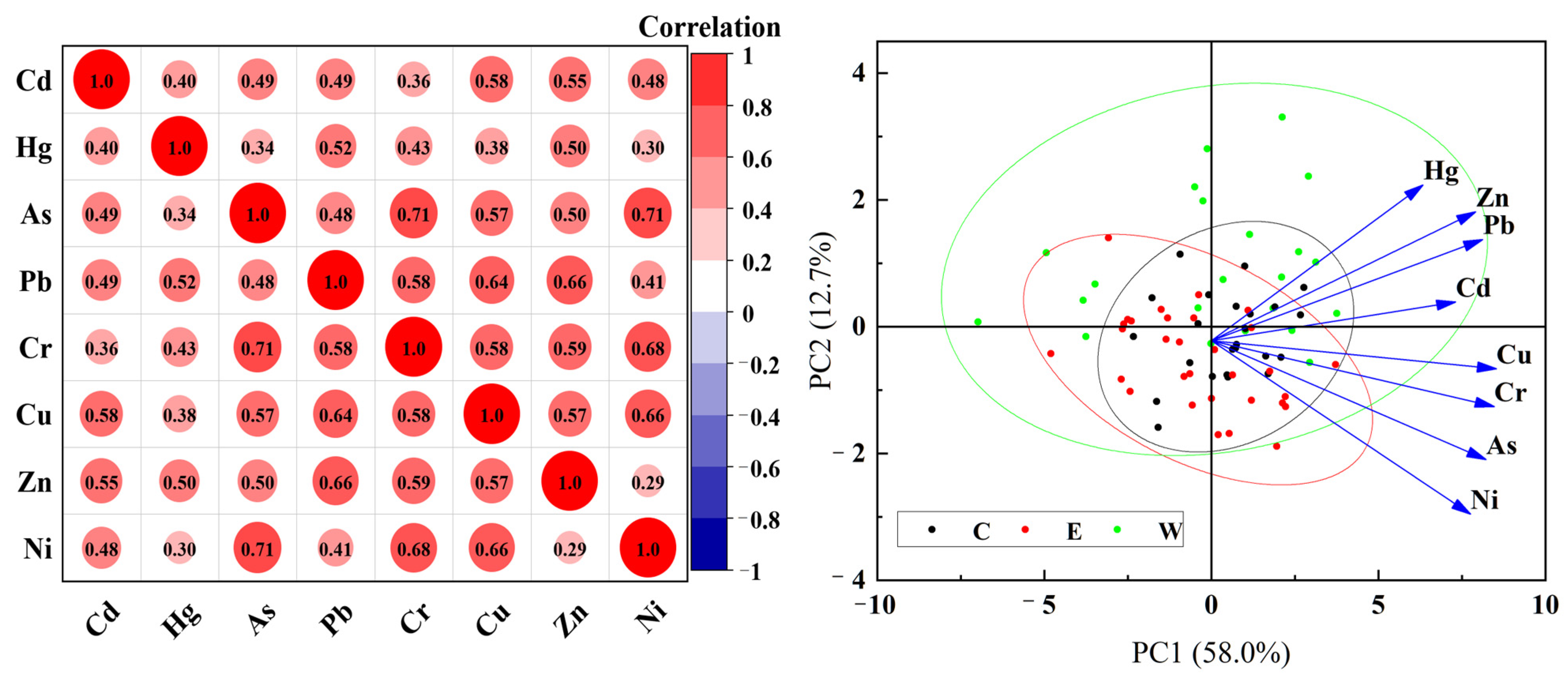
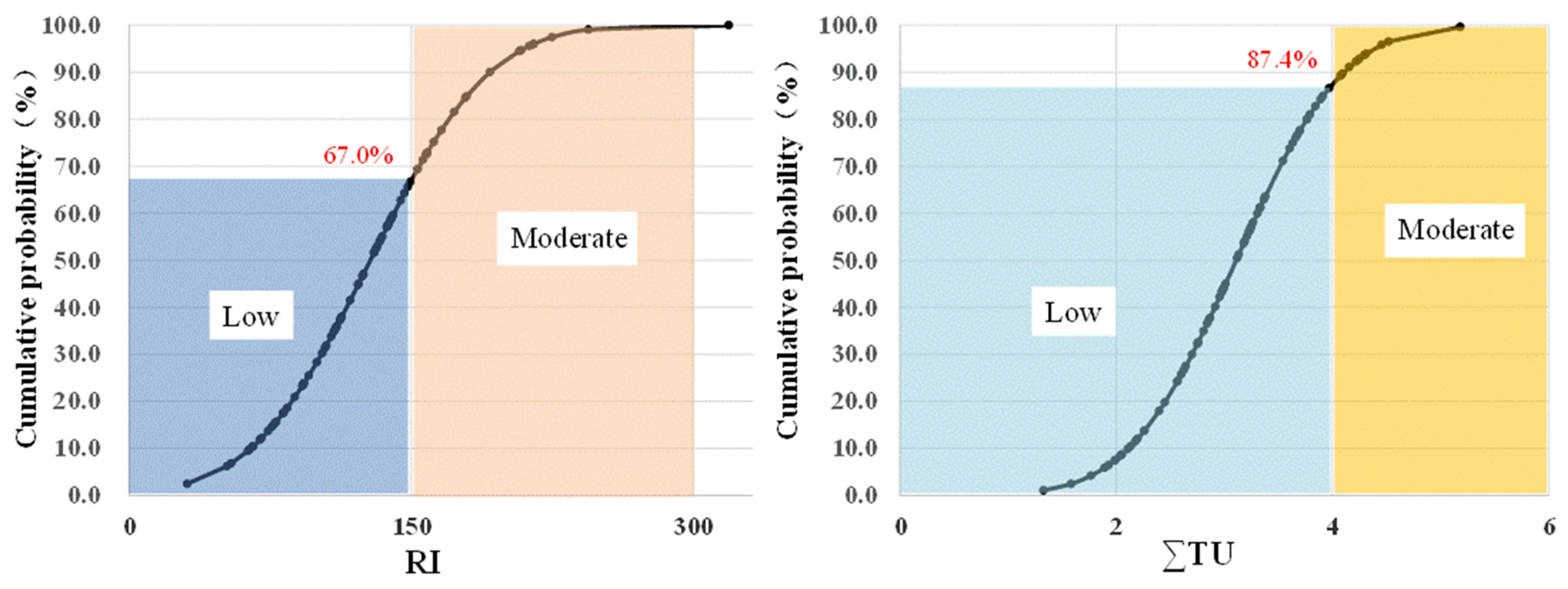
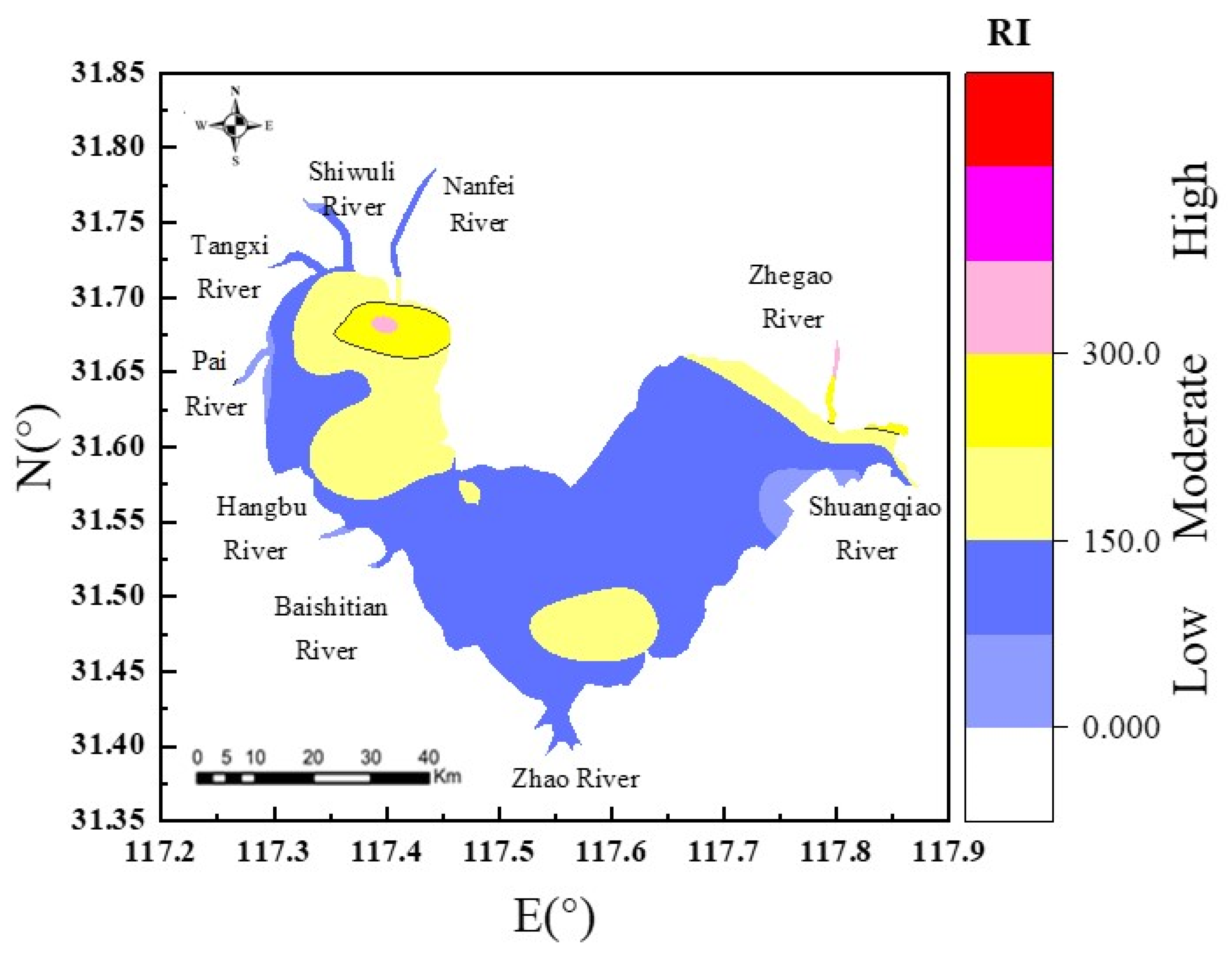
| Region | Element | Cd | Hg | As | Pb | Cr | Cu | Zn | Ni |
|---|---|---|---|---|---|---|---|---|---|
| W | Min | 0.04 | 0.013 | 1.75 | 14.1 | 39.3 | 11 | 39 | 10.3 |
| Max | 0.32 | 0.093 | 6.08 | 31.9 | 57.8 | 23 | 116 | 25.5 | |
| Mean ± sd | 0.17 ± 0.08 | 0.041 ± 0.023 | 3.79 ± 1.34 | 23.8 ± 5.3 | 49.2 ± 4.9 | 18 ± 3 | 71 ± 22 | 18.2 ± 3.1 | |
| C | Min | 0.07 | 0.024 | 0.75 | 8.7 | 35 | 13 | 34 | 10.2 |
| Max | 0.24 | 0.080 | 10.40 | 34.0 | 81.9 | 28 | 96 | 38.6 | |
| Mean ± sd | 0.15 ± 0.05 | 0.049 ± 0.014 | 3.55 ± 2.19 | 21.4 ± 6.1 | 52.6 ± 9.4 | 19 ± 4 | 66 ± 17 | 21.4 ± 6.0 | |
| E | Min | 0.07 | 0.017 | 2.35 | 8.9 | 37 | 10 | 29 | 16.4 |
| Max | 0.23 | 0.173 | 12.00 | 26.1 | 59 | 23 | 70 | 30.0 | |
| Mean ± sd | 0.15 ± 0.05 | 0.056 ± 0.029 | 4.43 ± 1.96 | 18.0 ± 4.5 | 49.3 ± 5.9 | 16 ± 3 | 51 ± 9 | 20.8 ± 3.6 |
| Concentration (mg/kg) | Cd | Hg | As | Pb | Cr | Cu | Zn | Ni |
|---|---|---|---|---|---|---|---|---|
| Background (in this study) | 0.150 | 0.041 | 3.55 | 18.5 | 49.2 | 16.0 | 51.0 | 18.2 |
| Background of trace metal in national lakes [31] | 0.162 | 0.048 | 8.88 | 21.3 | 52.9 | 11.4 | 41.2 | 21.3 |
| TEL | 0.596 | 0.174 | 5.9 | 35.0 | 37.3 | 35.7 | 123.0 | 18.0 |
| PEL | 3.530 | 0.486 | 17.0 | 91.3 | 90.0 | 197.0 | 315.0 | 36.0 |
Disclaimer/Publisher’s Note: The statements, opinions and data contained in all publications are solely those of the individual author(s) and contributor(s) and not of MDPI and/or the editor(s). MDPI and/or the editor(s) disclaim responsibility for any injury to people or property resulting from any ideas, methods, instructions or products referred to in the content. |
© 2025 by the authors. Licensee MDPI, Basel, Switzerland. This article is an open access article distributed under the terms and conditions of the Creative Commons Attribution (CC BY) license (https://creativecommons.org/licenses/by/4.0/).
Share and Cite
Luo, W.; Zhang, J.; Wang, M.; Zhao, J. Towards More Accurate Risk Assessment of Sediment Trace Metals: Integrating Sedimentary Background Determination and Probabilistic Evaluation in Chaohu Lake, China. Water 2025, 17, 1383. https://doi.org/10.3390/w17091383
Luo W, Zhang J, Wang M, Zhao J. Towards More Accurate Risk Assessment of Sediment Trace Metals: Integrating Sedimentary Background Determination and Probabilistic Evaluation in Chaohu Lake, China. Water. 2025; 17(9):1383. https://doi.org/10.3390/w17091383
Chicago/Turabian StyleLuo, Wenguang, Jiantao Zhang, Mian Wang, and Jinxiao Zhao. 2025. "Towards More Accurate Risk Assessment of Sediment Trace Metals: Integrating Sedimentary Background Determination and Probabilistic Evaluation in Chaohu Lake, China" Water 17, no. 9: 1383. https://doi.org/10.3390/w17091383
APA StyleLuo, W., Zhang, J., Wang, M., & Zhao, J. (2025). Towards More Accurate Risk Assessment of Sediment Trace Metals: Integrating Sedimentary Background Determination and Probabilistic Evaluation in Chaohu Lake, China. Water, 17(9), 1383. https://doi.org/10.3390/w17091383






